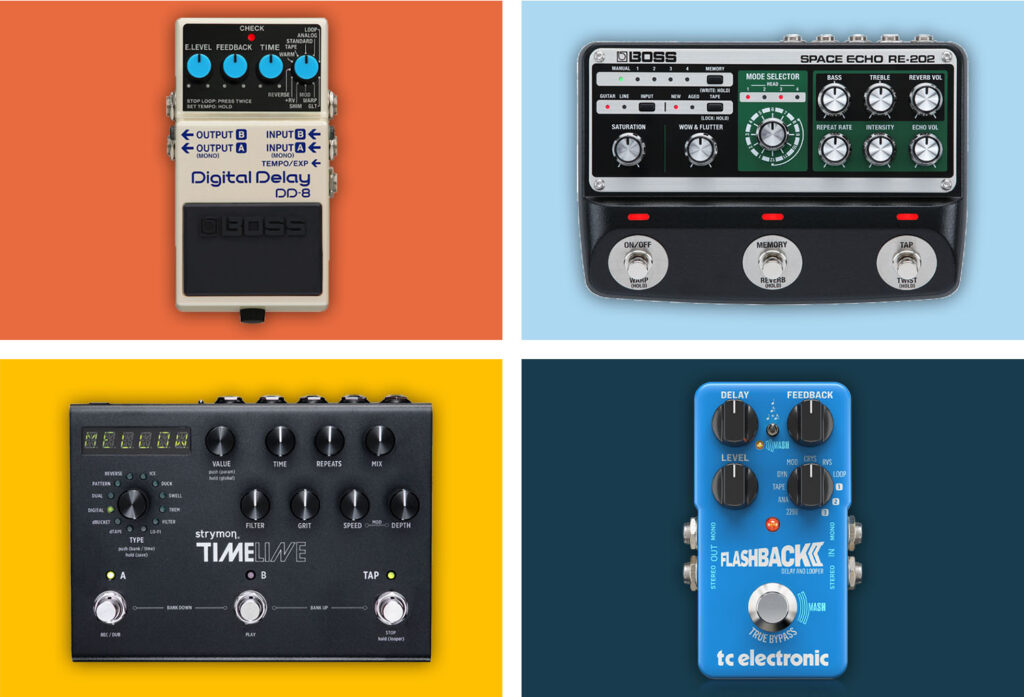Few effects in the world are as popular as delay. But not only among guitarists - delay (also known as echo) is often used in production for mixing and live with many instruments, including vocals.
What is a delay pedal?
A delay pedal is an effect device that was originally designed for electric guitars, but can be used with any audio source. It creates an echo effect by picking up the signal being played and repeating it after a short delay. The delay time can vary depending on the pedal model and setting, from very short echo effects (slapback delay) to longer repetitions.
Delay pedals always offer these settings:
- Delay time: Specifies how long it takes for the echo to be heard.
- Feedback: Controls how many times the echo is repeated. A higher feedback value results in more repetitions.
- Mix/Wet-Dry: Controls the relationship between the original signal (Dry) and the effect signal (Wet).
Many echo effects also offer additional settings, such as high-pass or low-pass filters for the echo, modulation for the echo, chorus, or reverb. These can be used to change the sound of the echoes.
There are different types of delay pedals - there are digital and analog delays, each with its own sonic character. Digital delays offer a clear and very precise repetition of the original signal, while analog delays are known for their warmer, sometimes slightly distorted echo sound (often with less highs and lows). More on this at the end of the article.
In a nutshell: Which delay pedal is the best?
The delay pedal with the best price-performance ratio is the Boss DD-8. It offers all the necessary features for under 170€, has 11 different delay modes and is also very small and handy.
But if you like vintage tape delays that simulate the classic tape echo sound of the '70s, the Boss RE-202 is your best bet.
If your budget is significantly higher, the Strymon Timeline is the most comprehensive delay pedal available - it leaves nothing to be desired.
The best delay pedals
Boss DD-8
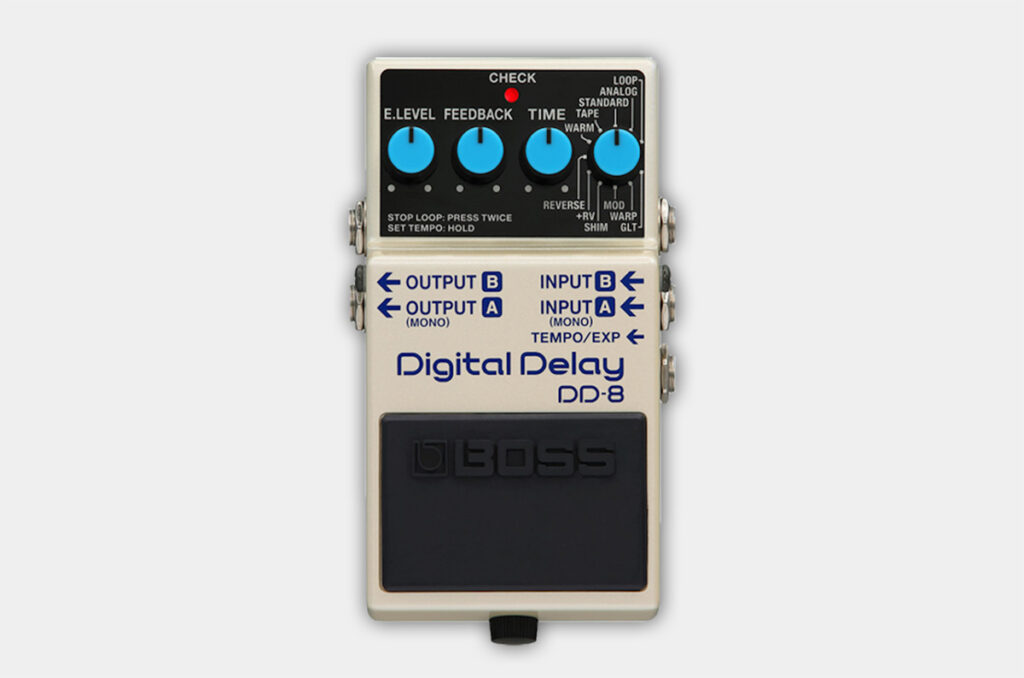
SPECIFICATIONS
Type: Digital Delay
Tap tempo: Yes
Bypass: Buffered
Stereo/Mono: Stereo
Delay modes: 11
Looper: Yes
LINK
Boss DD-8 Digital Delay (169€)
ARGUMENTS IN FAVOR
- Best price-performance ratio
- Compact, but with lots of features
- The small device contains 11 delay modes
NEGATIVE POINTS
- –
The Boss DD-8 is an evolution of the legendary Boss DD-3, the most popular delay pedal of all time. It has been in production for 30 years and is still available. The DD-8 has many additional features that make it the best value delay pedal available.
This pedal is small, but packed with features: it can be used in mono or stereo (so it has two inputs and outputs), has the usual three settings (Dry/Wet, Delay Time and Feedback) and an additional control to select different delay types. And that's the best part, in my opinion: this little pedal contains 11 different delay types (analog, tape, warm, reverse, etc.) and all of them are of incredibly good quality.
There is also an additional audio input for an expression pedal, which can be used to control feedback, or a tap tempo pedal, which can be used to "tap" the tempo. You can also do this without external pedals by pressing and holding the Footswitch for a few seconds. You will be in Tap Mode and can tap the tempo with your foot.
The Boss DD-8 is a very flexible pedal with a lot of features in a very small size and at a very good price - so you can say that it is the best delay pedal for guitarists and producers at the moment.
TC Electronic Flashback 2 Delay
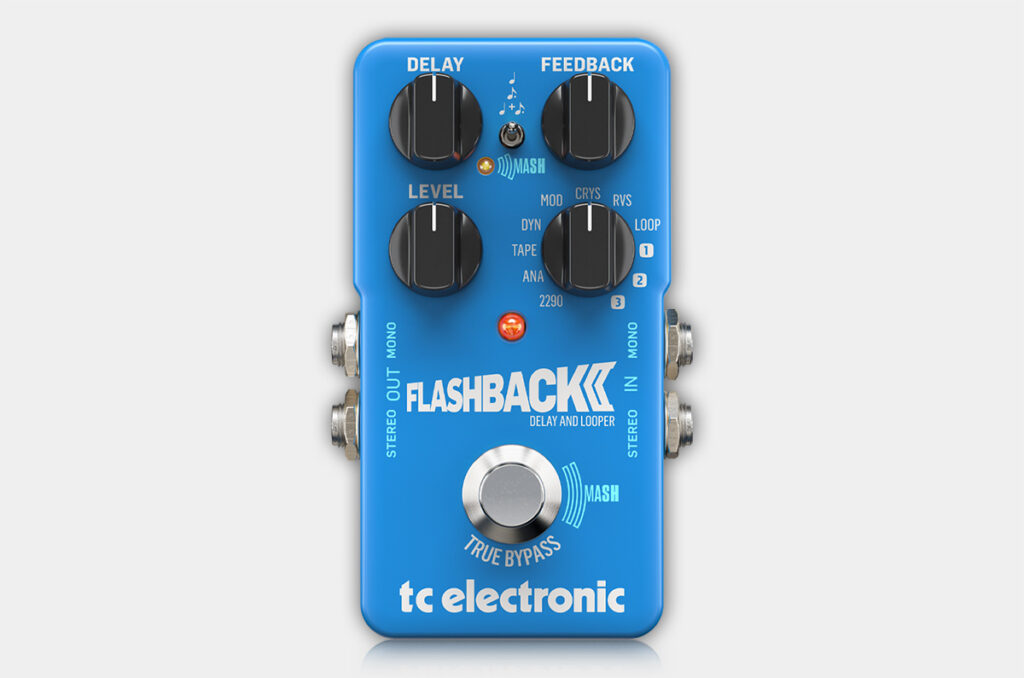
SPECIFICATIONS
Type: Digital Delay
Tap tempo: Yes (requires an update of the device)
Bypass: True Bypass
Stereo/Mono: Stereo
Delay modes: 11
Looper: No
LINK
ARGUMENTS IN FAVOR
- Expandable with additional presets thanks to MASH technology
- The footswitch is pressure-sensitive and thus enables expression control
- Unbeatable price
NEGATIVE POINTS
- Update (free of charge) required to use the tap function
This delay pedal from TC Electronic could almost take first place in the comparison - it costs a little less than the one from Boss and offers similar features. In addition to the three main controls (Delay Time, Feedback and Delay Volume), there is also a control that allows you to select 8 different delay modes.
In addition to these 8 modes, there are also 3 free slots for creating or importing your own effects via the TonePrint app. Through this app, TC Electronic offers a wide range of presets developed in collaboration with renowned guitarists, which can be easily imported into the pedal via mobile phone. The app can also be used to assign different parameters to the knobs, so you can really customize a lot.
Another great feature is that the footswitch doubles as an expression controller. It is pressure sensitive, meaning that it recognizes the difference between light and heavy pressure. You can then use this expression controller to control the various parameters - for example, you can place the feedback on top of it to create longer feedbacks in between. This is great for adding dynamics to the performance.
This pedal also works in stereo - so it has two inputs and outputs - but when used in mono, you can use the second input for a tap tempo pedal to tap the tempo. This also works without an external pedal.
Boss RE-202 Space Echo Delay/Reverb
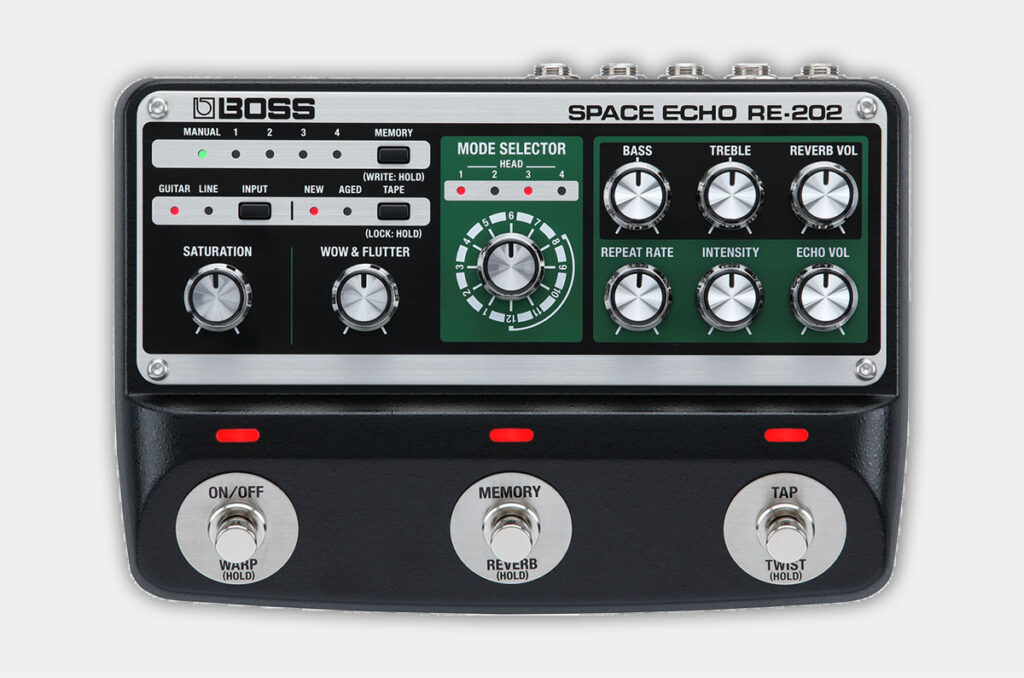
SPECIFICATIONS
Type: Tape modelling digital delay
Tap tempo: Yes
Bypass: Buffered
Stereo/Mono: Stereo
Delay modes: 12 (reverbs also included)
Looper: No
LINK
ARGUMENTS IN FAVOR
- Faithful replica of the legendary Roland Space Echo
- Vintage sound is incredibly good and gives a lot of character
- Reverb also included
NEGATIVE POINTS
- Does not sound clean - therefore not suitable for all situations
This delay pedal is my personal favorite because it imitates a very special and legendary effect device, the Roland Space Echo. This was one of the most popular studio delay effects and was still powered by analog tape. This gave the delay its very own character, which today we would call "vintage".
Since these units are no longer manufactured, Roland has released a new edition under the Boss brand (the Boss brand is also owned by Roland) that perfectly imitates the original sound but requires much less maintenance.
I have been using this delay myself for over 6 years (the first version was the Boss RE-20 - the second version is now available) for my productions because it simply sounds much better than all other plugins.
Each repetition of the delay sounds a bit more saturated than the one before, which is exactly the sonic character of old tape machines. But don't expect a "clean" delay - this pedal can't do that. The delays have a lot of character and can sound really "dirty", but that's what makes them so unique.
I can really recommend this pedal to any guitarist or producer who likes the vintage analog sound of tape delays - there is no better model in this area.
Universal Audio UAFX Orion Tape Echo
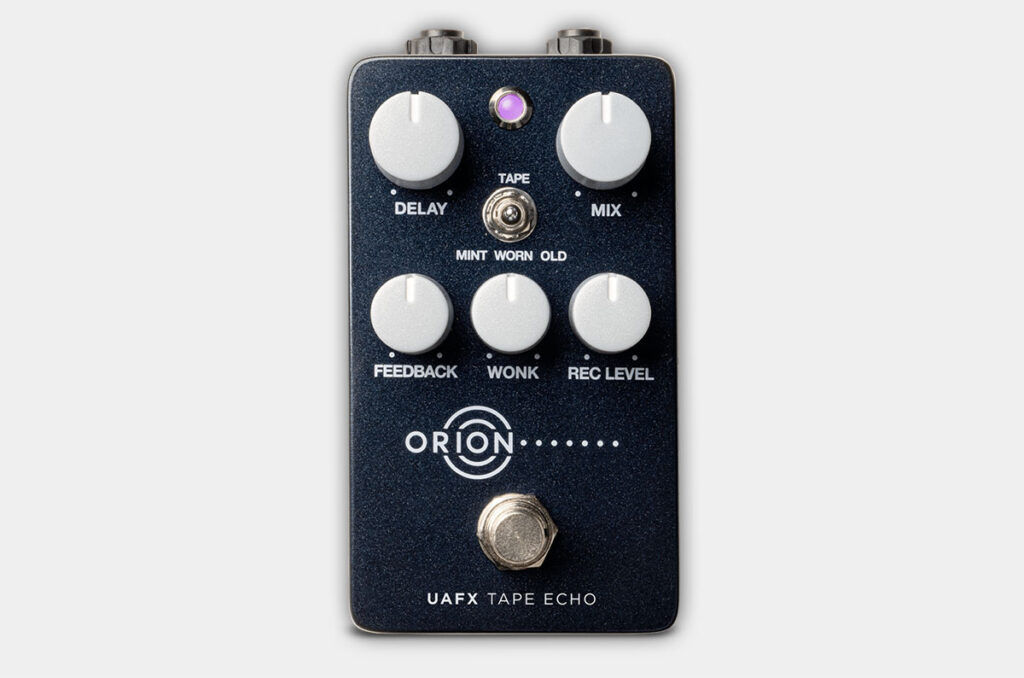
SPECIFICATIONS
Type: Tape modelling digital delay
Tap tempo: No
Bypass: True Bypass
Stereo/Mono: Mono
Delay modes: 3
Looper: No
LINK
ARGUMENTS IN FAVOR
- Faithful replica of the legendary Maestro Echoplex EP-3
- Beautiful vintage sound
- The preamplifier sounds extremely good and adds a lot of character
NEGATIVE POINTS
- Does not sound clean - therefore not suitable for all situations
This pedal is also an emulation of a well-known classic tape delay, the Maestro Echoplex EP-3, another tape delay that was very popular in the 70's and whose sound would be considered "vintage" today.
The special feature of this delay pedal is the built-in switchable preamplifier, which can be used to add saturation to the input signal to make the sound "dirtier". This effect provides a warm sound that can be used without a delay effect and works well with many synthesizers. The preamp can be turned on and off with a switch on the rear panel, and the gain can be adjusted with the "Rec Level" knob.
Three different tape delay modes are available (Mint, Worn, Old) and the Wonk control can be used to modulate the delay to make it even more interesting. The pedal is mono only and has only one input and one output.
Strymon Timeline
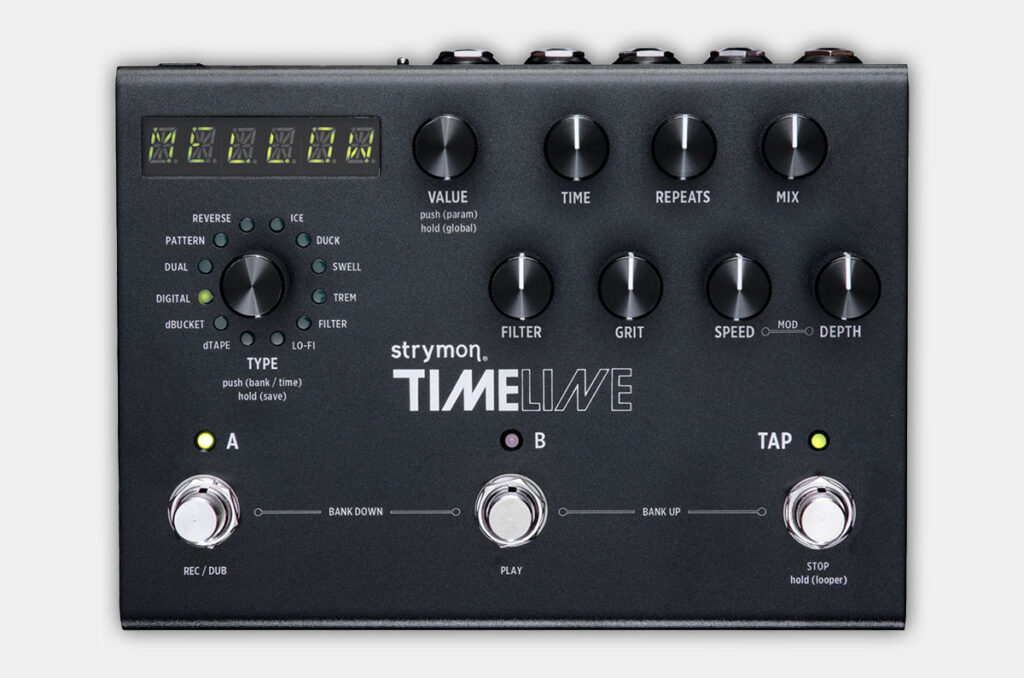
SPECIFICATIONS
Type: Digital Delay
Tap tempo: Yes
Bypass: Buffered
Stereo/Mono: Stereo
Delay modes: 12
Looper: Yes
LINK
Strymon Timeline (479€)
ARGUMENTS IN FAVOR
- Lots of features
- MIDI connectivity
- Additional filters, grit controls and modulation offer endless possibilities for shaping the sound.
NEGATIVE POINTS
- Not cheap
This effect unit is more of a "delay station" than a "delay pedal" because of its size. It is at least three times the size of most pedals (in classic Boss size), but it also has stereo inputs and outputs, an expression pedal input, and MIDI inputs and outputs.
The MIDI connections are especially interesting if you want to use the pedal with a DAW, as they allow communication between the pedal and the DAW. The pedal offers a total of 12 different delay modes, the usual settings (time, feedback, mix), but also an additional filter, grit control (for more character) and modulation controls (speed and depth).
A special highlight of this pedal is the ability to store and recall different presets - two of which can be selected directly via the two A and B footswitches, with room for a total of 200 presets. In addition to these two preset footswitches, there is also a Tap Tempo footswitch that allows you to tap in the delay time.
The pedal also has a loop function that allows you to record up to 30 seconds. With all these features, this delay pedal is the most comprehensive in the comparison, which is also reflected in the price. It costs just under $500, making it the most expensive pedal in the comparison.
Harley Benton Digital Delay
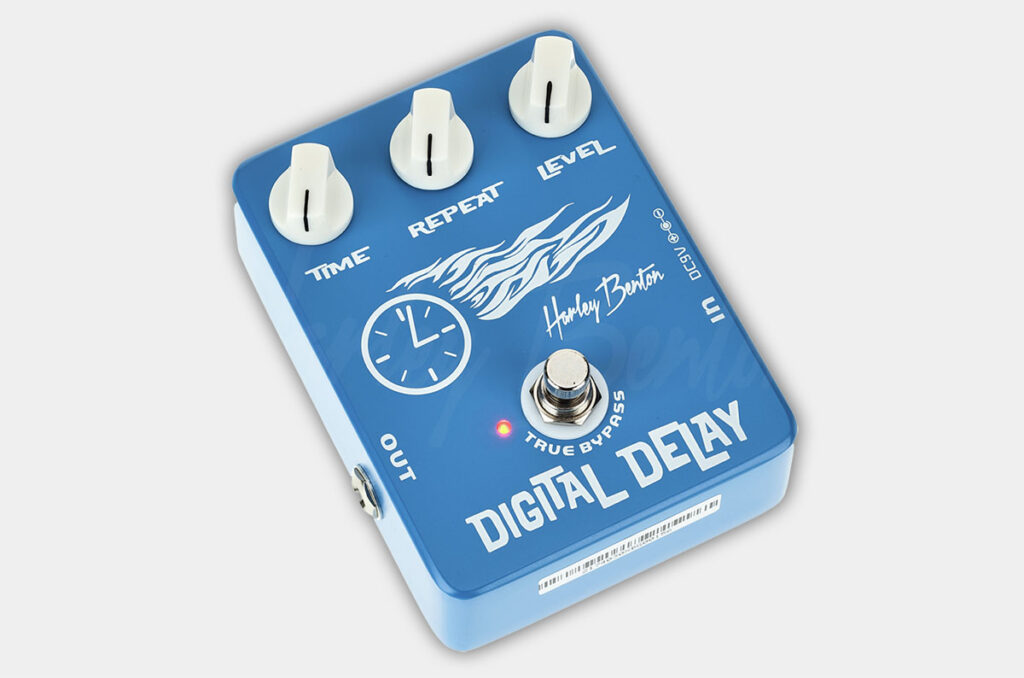
SPECIFICATIONS
Type: Digital Delay
Tap tempo: No
Bypass: True Bypass
Stereo/Mono: Mono
Delay modes: 1
Looper: No
LINK
Harley Benton Digital Delay (29,90€)
ARGUMENTS IN FAVOR
- Very cheap
- Basic functions included
NEGATIVE POINTS
- No additional functions
If you are looking for an inexpensive solution, you should choose the Harley Benton delay pedal. It is very simple and straightforward: It offers only three basic parameters: delay time, feedback and wet/dry (even if they are called something else). It also has only one input and one output.
You can't connect an expression pedal or tap the tempo, but you can't expect those features for less than $30. This pedal simply does what a delay is supposed to do - repeat and nothing else.
And it does this very well. You can create very short slapback delays that sound almost like reverb, or long, almost infinite delays by turning up the time and repeat controls.
But don't expect much more - if you're looking for something special, look elsewhere. This delay pedal can only sound clean and adds very little color to the sound.
tc electronic 2290 P Dynamic Delay Pedal
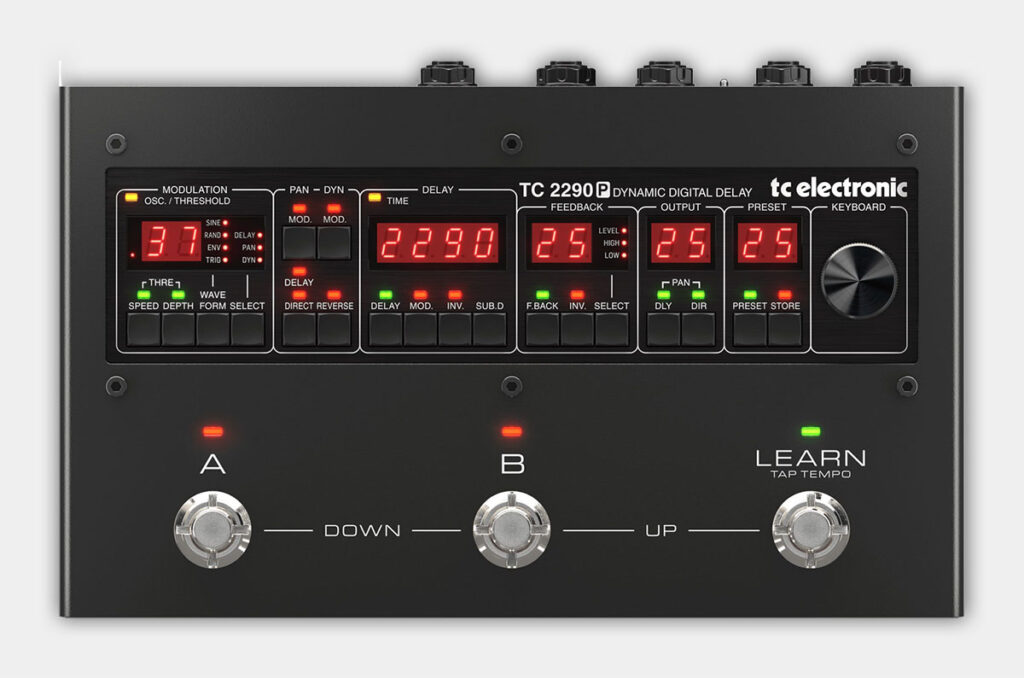
SPECIFICATIONS
Type: Digital Delay
Tap tempo: Yes
Bypass: Buffered
Stereo/Mono: Stereo
Delay modes: 128 presets
Looper: Yes
LINK
ARGUMENTS IN FAVOR
- Many functions
- Very precise adjustment are possible
- Many extras such as chorus, flanger, tremolo, vibrato, phaser, panning, ducking and compression
NEGATIVE POINTS
- –
This delay pedal is the new edition of a legendary studio delay, the TC Electronic 2290, a delay unit that can be found in 90% of all professional studios worldwide. And the new edition leaves nothing to be desired!
This is a digital delay that allows you to set all kinds of parameters very precisely. There is only one master knob, but lots of buttons and an LCD display where you can read every value precisely.
There are a total of 128 presets, all of which are very useful. Two of them can be assigned to the two footswitches, so they are always at hand. It can operate in both mono and stereo modes. In mono mode, the remaining input and output can be used as an FX loop to connect additional effects.
In addition to the usual controls, this delay pedal offers a few more options such as extensive modulation options and L/R panning. This pedal can be used as a delay for mixing, and the MIDI connections make it easy to control from a computer/laptop.
With a retail price of 359€, this delay is not exactly cheap - but considering what it can do, I think the price is more than reasonable (an original TC Electronic 2290 from the 80s costs over 2000€ today).
MXR M169 Carbon Copy Analogue Delay
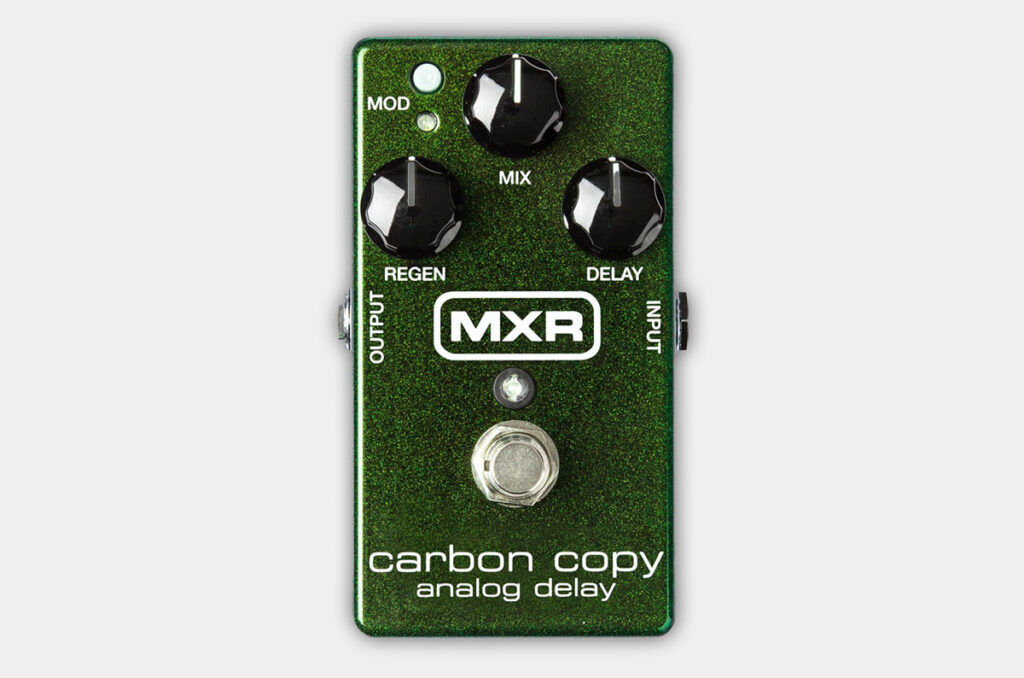
SPECIFICATIONS
Type: Analog Delay
Tap tempo: No
Bypass: True Bypass
Stereo/Mono: Mono
Delay modes: 1
Looper: No
LINK
ARGUMENTS IN FAVOR
- 100% analog
- Very nice, warm sound that becomes very saturated with long feedback.
- Modulation sounds very good
NEGATIVE POINTS
- Not as many extra functions as other models
This delay pedal is 100% analog and you can hear it. It delivers one of the best sounds in this comparison, and that's because of the analog technology. It has a warmth and a certain "imprecision" that is very difficult to reproduce with digital delays.
And that's the biggest plus of this pedal, because it doesn't have many other features. In addition to delay time, feedback, and dry/wet, there is also a modulation switch that adds a chorus-like modulation to the signal, which also sounds quite good.
You can really hear the great analog sound when you turn up the feedback and listen to a lot of repeats - each repeat sounds a little "dirtier" and warmer than the one before, similar to tape delays. This results in a great vintage character.
This pedal has been around for over 10 years and not much has changed in that time - but why should it, because it still offers one of the best sounds on the market. So if you are a "sound purist" and are looking for a warm, analog sound, but can do without the extra features, then this is the pedal for you.
Line6 DL4 MKII Delay
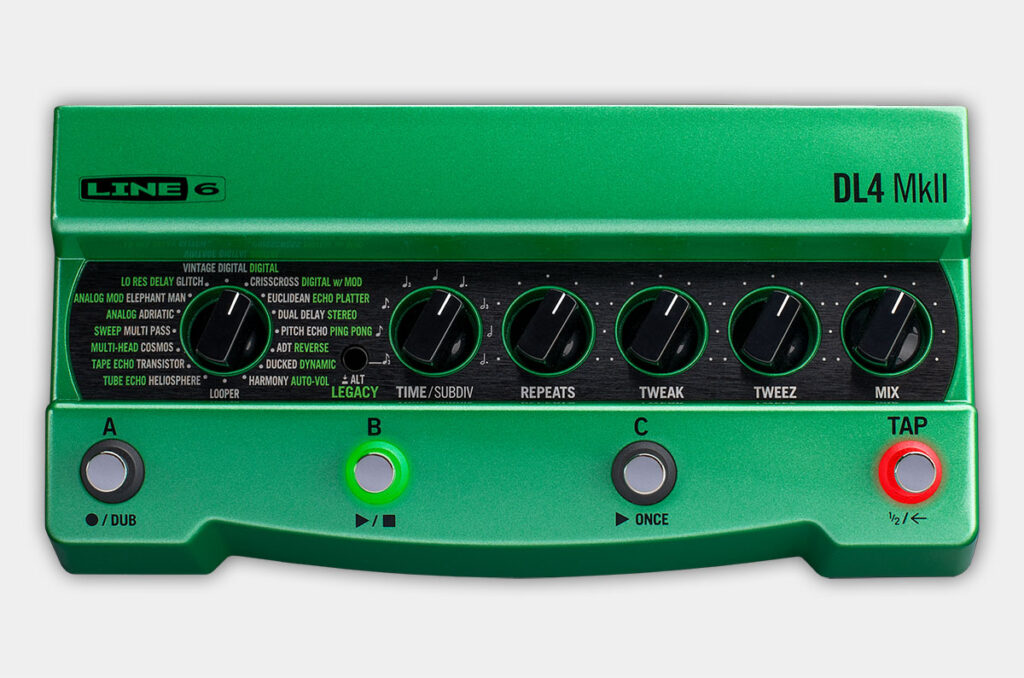
SPECIFICATIONS
Type: Digital Delay
Tap tempo: Yes
Bypass: Buffered
Stereo/Mono: Stereo
Delay modes: 30 (128 presets)
Looper: Yes
LINK
Line6 DL4 MKII Delay (319€)
ARGUMENTS IN FAVOR
- Very extensive
- The "Tweak" and "Tweez" controls allow you to fine-tune the various delay modes
- 6 presets can be called up directly via the footswitches
NEGATIVE POINTS
- Many extra functions are not particularly easy to access
Line6 is known for its high-quality effects units for guitarists, and the DL4 Delay is one of its flagship products. It offers 30 different delay modes, 128 presets, and 4 footswitches in a relatively large unit. It also has a loop function with 240 seconds of recording time.
Six presets can be recalled directly from the footswitches, which should be enough for most guitarists. All others can be selected using the knobs. The DL4 also has MIDI inputs and outputs for connecting to a computer.
The sound quality of all delays is extremely good and very realistic - especially the analog simulations sound very real. In addition to the three main controls for Delay Time, Feedback, and Dry/Wet, there are also the "Tweak" and "Tweez" controls. The function of these two controls varies depending on the selected delay mode. For example, in Tube Echo mode they control the saturation and decay of the delay, while in Tape Echo mode they control the treble and bass.
This delay pedal is extremely versatile and can be used as an electric guitar stompbox or as a mixing effect.
What's the difference between analog and digital delays?
Analog delays use analog circuits, often based on Bucket Brigade Devices (BBDs) (most were tape-based in the past), to delay audio signals. BBD chips contain a chain of capacitors that pass the signal from one to the other, creating a delay.
They are known for their warm, mellow, and sometimes slightly distorted sound. Because the quality of the delay decreases with time and the amount of feedback, they tend to have a natural decay that is often described as "musical". On the downside, they usually have a shorter maximum delay time and are less flexible in terms of settings and control.
Digital delays use digital signal processing (DSP) to create the delay effect. The incoming audio signal is digitalized (converted into binary data), then delayed and converted back into an analog signal.
They deliver a very clean and precise sound and can offer much longer delay times than analog units. In addition, they often offer greater versatility with different types of delay simulations (e.g. tape, bucket brigade, digital echo) and additional features such as tap tempo, modulation effects, and the ability to save presets.
So you could say that analog delays add character to the signal, while digital delays don't add character, but they can handle longer delay times and the signal remains clean and undistorted even with very long feedback.
Related articles:





